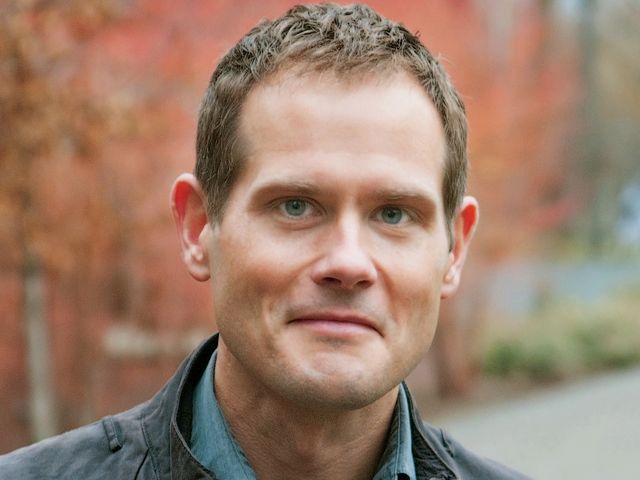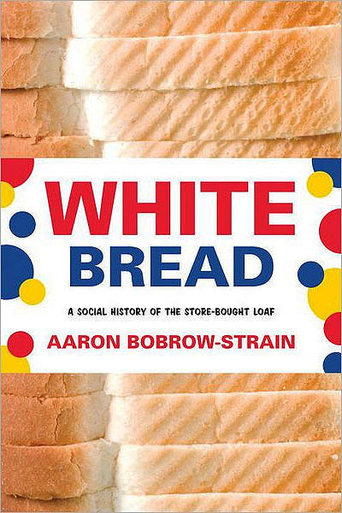
reference-image, l
(article, Amy Halloran)
[%pageBreakSettings nobreak=true] p(blue). Aaron Bobrow-Strain studies politics, especially the politics of food and agriculture. And he loves bread. In his recently published White Bread: A Social History of the Store-Bought Loaf, Bobrow-Strain kneads these two interests together. p(blue). White Bread uses factory-produced bread as a lens for looking at the history of food movements in America. Bobrow-Strain traces the various attitudes toward bread specifically, and the American diet in general, that have circulated with the rise of the industrialized food system. Why did you use bread to look at food movements? I think honestly because I’m just a total bread-baking geek. I’ve been an artisanal bread baker going back to the early 1990s, and am just in love with everything related to bread. But once I got into it, I realized that if you look at industrial white bread, it’s our most fought-over food. Every food guru, social reformer, dietary expert, and government official in the past 150 years has wanted to change America’s bread, or America’s bread habit in some way. It becomes a really fun kind of lens to look at how we battle over what we should eat, and how we fight over the American diet. From the late 19th century till the early 1960s, Americans got more of their daily calories from bread than any other food. It averaged from 25 percent to as high as 40 percent of average daily calories during that period. So it's not surprising that it becomes a really good window into looking at how we fight about our food and battle over the food system. [%image Aaron float=right width=300 caption="Aaron Bobrow-Strain"] What most surprised you as you researched this book? I came at it assuming that the backlash began with the 1960s counterculture. I had no idea that this had been going on for 150 years. It was this ongoing back-and-forth battle. In the 1920s and 1930s, there was a huge outpouring of concern that is so resonant with today. In the 1920s, you had people talking about how industrial white bread was making people fat, dumb, and lazy. Some of it sounds like it’s straight out of a gluten-free-diet book today. How do trends play into attitudes toward bread and other foods? They do tend to peter out. But they also leave a cultural mark. None of my students had ever heard of the big home-baking revitalization of the 1970s, this cultural moment when everyone was interested in baking bread. My parents, Vogue magazine — all these different people were talking about the importance of baking your own bread. And that just disappeared after a while. But I think it does leave a mark in terms of changed patterns of bread consumption. Even if people aren’t baking their own bread anymore, it creates a certain consciousness. There’s a sense in which the amount of focus that we have on food might not last, because a certain amount of it is a narcissistic niche-market fad. But it will still leave a mark. That’s a big take-home point of my book: that these movements channel the best of our desires to change the world and make an impact, but they are also these self-involved fads that often end up reinforcing social inequalities. You encourage food dreamers to modify their visions to support social justice, rather than further social stratification. Do you have ideas about how that can happen? I think the food movement has allowed us to be convinced a consumer-driven approach is the only way to change the food system. At least some of us can buy our way to a better food system by paying more at the cash register for better food. But in the end, it’s kind of a Reagonomics supply-side model. I think it’s that it’s not that difficult to take another approach. The first thing is something that my book clearly brings up, and it’s starting to emerge today. The idea is that we need a more robust concept of food justice, where food justice is more than a privileged "us" helping "them" get access to good food, but also a question of wages and inequality and food-chain workers, the kind of folks that tend to get left out of foodie politics these days. The fact that food movements tend to forget about food workers goes way back in history. I think the current food movement really needs to engage in a much more meaningful way with poor people’s groups and social-justice groups. Not just going to them and saying, "How can we bring you our good food?" but more, "How can we work together to create the kind of social justice on the ground that will allow people to eat better?" I think a good place to start is food-chain workers, because they’re connected to the food system that we care about changing, and they are among the most marginalized and food-insecure people in the country. [%image bookcover float=left] The second thing that’s really important to getting away from the trickle-down approach is to refocus on the rules governing the production of all food. Right now we’ve got this historically unprecedented concentration and consolidation of power in the hands of a few big food companies that allows them to define what we eat virtually with no regulation or oversight. It’s amazing that the food movement doesn’t do more to challenge that directly. I think there’s a great example recently coming out of California, with the struggle over methyl iodide. You had an alliance between farmworkers, the food movement, small strawberry producers, and environmental groups, and they came together. They didn’t come together to define a consumer-driven solution. They didn’t come together to create a new label of methyl-iodide-free strawberries where some affluent people could pay more to get methyl-iodide-free strawberries and the rest of us could get methyl-iodide-rich strawberries. They came together and said, "We cannot have this chemical. It’s too dangerous." And the company withdrew methyl iodide from the market. When we do try to target powerful food companies more directly, we can actually make a big change. It doesn’t all have to be at the cash register. p(bio). Amy Halloran lives in upstate New York with her two sons, husband, and nine chickens. They garden their six city lots to have food for most seasons.

reference-image, l

Aaron, l

bookcover, l